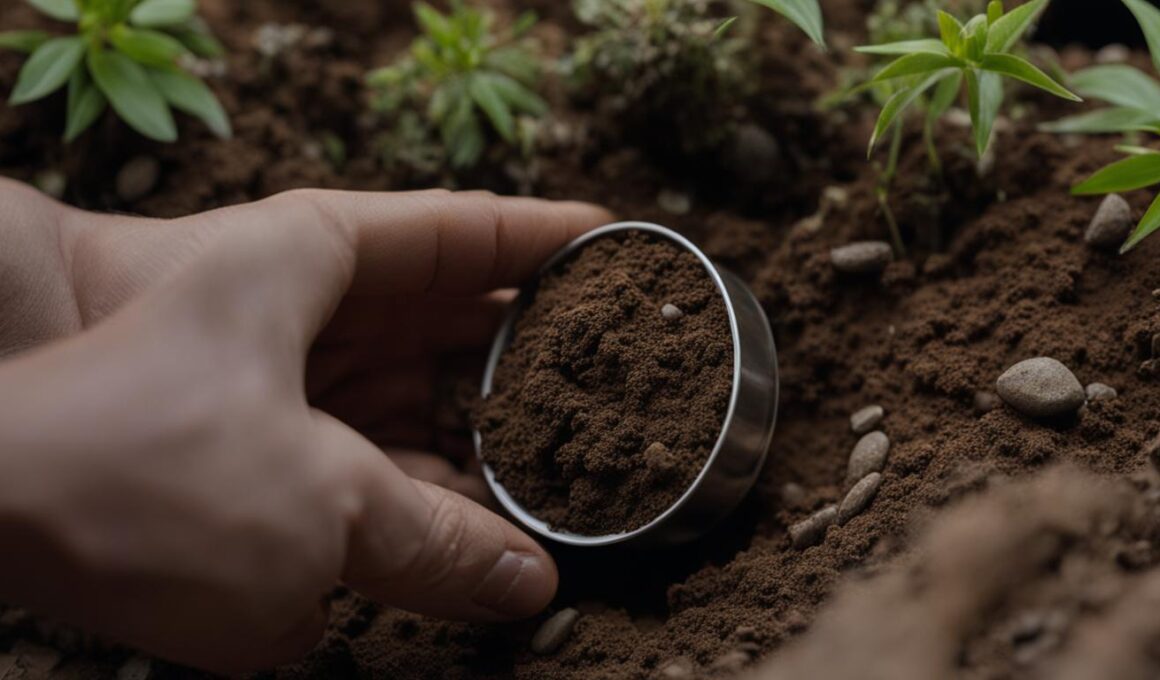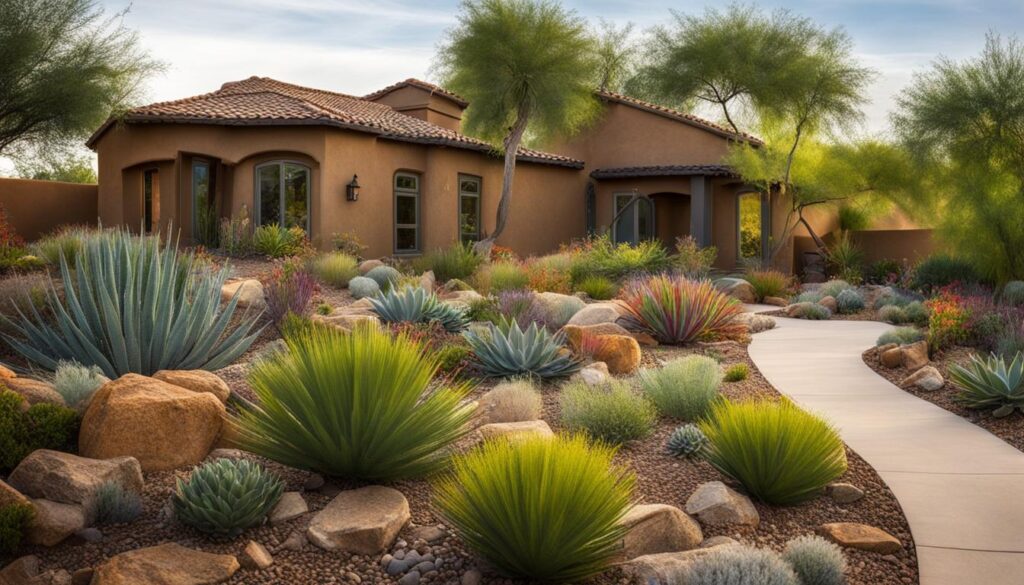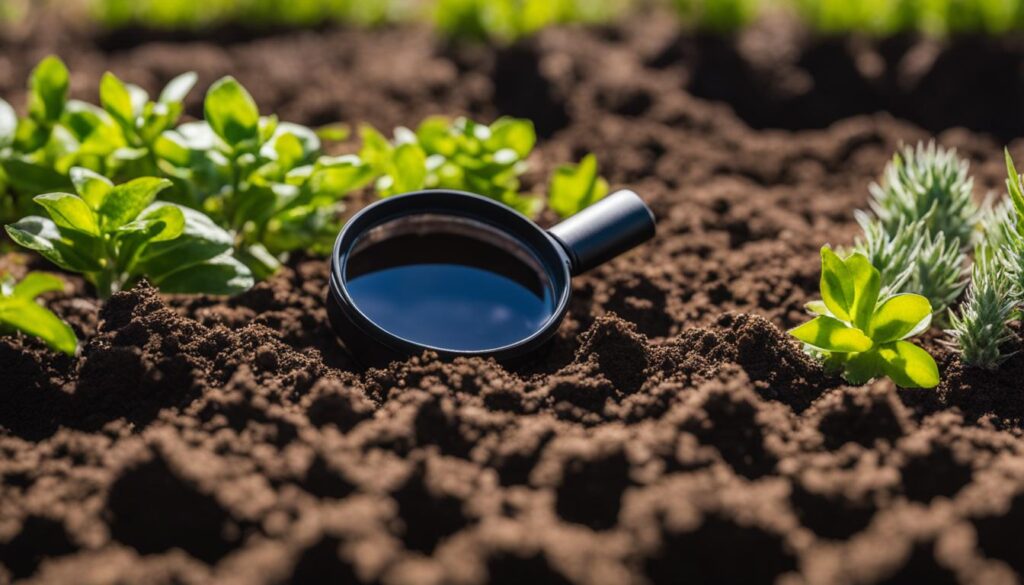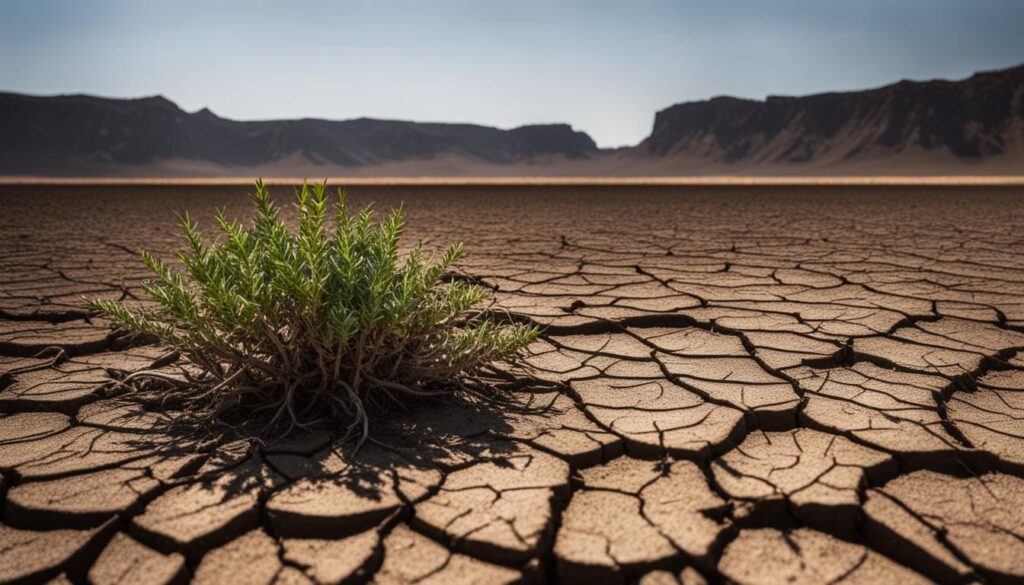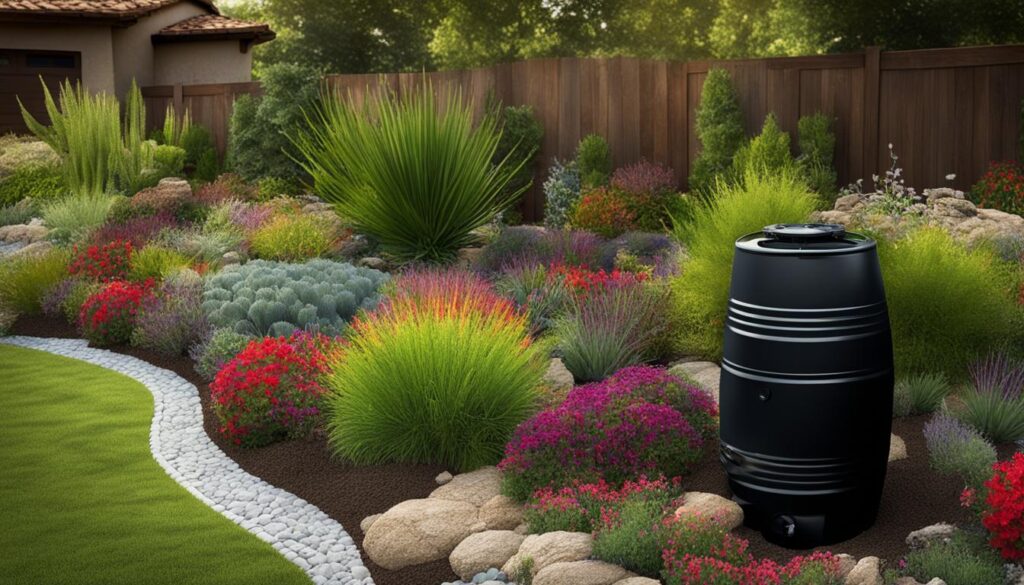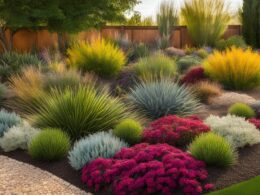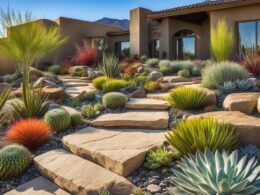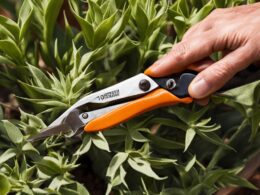Xeriscaping is a popular landscaping method that focuses on conserving water and promoting plant health in arid regions. One crucial aspect of successful xeriscaping is conducting soil testing and analysis. By understanding the composition of the soil, its fertility levels, and potential contaminants, gardeners can make informed decisions about plant selection, watering schedules, and soil amendments. In this comprehensive guide, we’ll explore the importance of xeriscape soil testing and analysis and provide expert tips and recommendations for achieving a thriving xeriscape garden.
Key Takeaways:
- Xeriscape soil testing and analysis are vital for successful water-efficient gardening.
- Understanding soil composition, fertility levels, and potential contaminants helps inform plant selection and soil amendments.
- Accurate soil sampling and testing are crucial for obtaining reliable results.
- Interpreting soil test results guides proper soil amendments and plant care.
- Water management and maintaining soil health are essential for thriving xeriscape gardens.
Understanding the Basics of Xeriscape Gardening
Xeriscape gardening is a landscaping approach that focuses on using drought-tolerant plants, efficient irrigation systems, and mindful water management techniques to create beautiful, sustainable gardens. By reducing water consumption and promoting plant health, xeriscape gardening offers numerous benefits, including lower water bills, reduced maintenance, and increased resilience to drought conditions.
One of the core principles of xeriscape gardening is water-efficient landscaping. This involves selecting plants that have adapted to arid climates and require minimal water. Native plants, succulents, ornamental grasses, and Mediterranean plants are popular choices for xeriscape gardens due to their ability to thrive in water-scarce environments. By choosing the right plants for your xeriscape garden, you can create a visually appealing landscape that conserves water and requires less maintenance.
In addition to plant selection, efficient irrigation systems play a pivotal role in xeriscape gardening. Drip irrigation is a commonly used method in which water is delivered directly to the plants’ root zones, minimizing wastage through evaporation and runoff. Mulching is another water-saving technique that helps retain moisture in the soil, reducing the need for frequent watering. By implementing best practices for water management, such as strategic plant placement and proper irrigation, you can maximize water efficiency in your xeriscape garden.
Xeriscape gardening is not only environmentally friendly but also aesthetically pleasing. The careful selection of plant species, combined with efficient water management, can create a vibrant and sustainable landscape. Whether you live in an arid region or simply want to minimize water consumption, xeriscape gardening offers a practical and beautiful solution for your outdoor space.
The Importance of Soil Testing in Xeriscape Gardens
Xeriscape gardens are designed to thrive in arid regions with minimal water usage. To ensure the success of these gardens, it is crucial to conduct soil testing and analysis. Soil testing provides valuable insights into the unique characteristics of the soil, including pH levels, nutrient content, and potential contaminants. By understanding these factors, gardeners can make informed decisions regarding plant selection, fertilization strategies, and soil amendments, ultimately leading to a thriving xeriscape garden.
One of the primary reasons soil testing is essential in xeriscape gardens is that it helps determine the pH level of the soil. Different plants thrive in different pH ranges, and by knowing the pH of the soil, gardeners can select plants that are well-suited to the conditions in their garden. In addition, soil testing reveals the nutrient content of the soil, enabling gardeners to tailor their fertilization strategies to the specific needs of their plants. This ensures that plants receive the necessary nutrients for optimal growth without over-fertilizing, which can lead to environmental issues.
Soil testing also plays a crucial role in identifying any potential contaminants or heavy metal presence in the soil. This is particularly important for xeriscape gardens, as these gardens often rely on harvested rainwater or greywater for irrigation. By conducting soil tests, gardeners can ensure the safety and health of both plants and gardeners by identifying any potential risks and taking appropriate measures to mitigate them.
Table: Benefits of Soil Testing in Xeriscape Gardens
| Benefits | Description |
|---|---|
| Optimal plant selection | By knowing the pH level of the soil, gardeners can choose plants that are well-suited to their garden’s conditions. |
| Precise fertilization | Soil testing reveals the nutrient content of the soil, allowing gardeners to provide the necessary nutrients for plant growth without over-fertilizing. |
| Identification of contaminants | Soil testing helps identify any potential contaminants or heavy metals, ensuring the safety and health of plants and gardeners. |
Overall, soil testing is a critical step in the journey towards a successful xeriscape garden. By understanding the unique characteristics of the soil through testing and analysis, gardeners can make informed decisions about plant selection, fertilization strategies, and soil amendments, creating an environment that promotes plant health and conserves water.
How to Collect Soil Samples for Testing
Collecting accurate soil samples for testing is crucial to obtain reliable results. To collect soil samples for xeriscape garden analysis, gardeners should follow specific guidelines. It’s important to take samples at a consistent depth and from various areas in the garden to ensure representativeness. Avoid areas with distinct differences such as over or under-performing vegetation, animal gathering spots, or areas near fence lines. The collected soil samples should be properly labeled, sealed, and sent to a certified soil testing laboratory for analysis. Following the correct sampling process ensures accurate and actionable results.
When collecting soil samples, it’s essential to consider the depth at which the sample is taken. The University of Arizona Cooperative Extension recommends sampling soil to a depth of 6-8 inches for turfgrass and 12 inches for vegetable gardens. Use a soil probe or a clean garden trowel to collect the samples. Take multiple samples from different areas within the garden and avoid areas that have been recently fertilized or treated with pesticides. This will provide a more accurate representation of the overall soil composition in your xeriscape garden.
| Step | Description |
|---|---|
| Step 1 | Use a soil probe or garden trowel to collect soil samples. |
| Step 2 | Collect samples at a consistent depth, such as 6-8 inches for turfgrass and 12 inches for vegetable gardens. |
| Step 3 | Take multiple samples from different areas within the garden to ensure representativeness. |
| Step 4 | Avoid sampling areas that have been recently fertilized or treated with pesticides. |
| Step 5 | Label and seal the soil samples before sending them to a certified soil testing laboratory for analysis. |
Proper labeling and sealing of the soil samples are essential to maintain their integrity during transportation. Label each sample with the date, location, and a unique identifier. Place the samples in a clean plastic bag or container, ensuring that there are no leaks or air gaps. Keep the samples cool and dry during transportation to the laboratory. Sending the samples to a certified soil testing laboratory will provide accurate analysis and recommendations based on the specific needs of your xeriscape garden.
Interpreting Soil Test Results for Xeriscape Gardens
Once you’ve received the results of your xeriscape garden soil test, it’s important to know how to interpret the findings. The soil test report will typically provide information on the pH levels, nutrient content, and any potential contaminants in your soil. Understanding these results will help you make informed decisions about soil amendments and plant selection, ensuring the long-term health and success of your xeriscape garden.
The soil test results will be presented in numerical values and bar charts, indicating whether the levels are below, within, or above the recommended range. Pay close attention to the nutrient recommendations section of the report, as this will provide guidance on how to amend your soil for optimal plant growth. Adjusting pH levels, adding organic matter, or incorporating specific fertilizers may be necessary to create the ideal conditions for drought-tolerant plants in your xeriscape garden.
Understanding the soil test results will also help you identify any potential contaminants or heavy metal presence that may pose a risk to both your plants and your health. If high levels of contaminants are detected, it’s important to take appropriate measures to mitigate their impact and ensure the safety of your garden environment.
Example Table: Soil Test Results Summary
| Nutrient | Recommended Range | Your Soil Test Results | Amendment Recommendations |
|---|---|---|---|
| Nitrogen (N) | 25-50 ppm | 30 ppm | No amendment needed |
| Phosphorus (P) | 10-20 ppm | 7 ppm | Add organic phosphorus fertilizer |
| Potassium (K) | 50-100 ppm | 110 ppm | No amendment needed |
| pH | 6.0-7.0 | 5.5 | Add lime to raise pH |
Note: The values and recommendations in the table are for illustrative purposes only and may not reflect your actual soil test results.
Importance of Soil Amendments in Xeriscape Gardens
Soil amendments are essential for maintaining soil fertility and creating optimal conditions for plant growth in xeriscape gardens. By incorporating the right amendments, gardeners can improve soil structure, enhance water retention capabilities, and provide necessary nutrients for plants. This section will explore the importance of soil amendments in xeriscape gardens and provide valuable tips on choosing and applying the right amendments.
Choosing the Right Soil Amendments
When selecting soil amendments for xeriscape gardens, it’s important to consider the specific needs of the soil and plants. Organic matter, such as compost and well-rotted manure, can improve soil fertility, enhance moisture retention, and promote beneficial microbial activity. Additionally, adding perlite or vermiculite can improve soil drainage and aeration, preventing waterlogged conditions in heavy clay soils. It’s crucial to choose amendments that align with the goals of xeriscape gardening, such as water conservation and reduced maintenance.
Applying Soil Amendments
Proper application of soil amendments is key to achieving desired results in xeriscape gardens. Before applying amendments, gardeners should conduct soil tests to determine the nutrient levels and pH of the soil. Based on the test results, the appropriate amendments can be added at the recommended rates. It’s important to thoroughly mix the amendments into the top layer of the soil to ensure even distribution. Regular monitoring of soil moisture levels and periodic reapplication of amendments may be necessary to maintain optimal soil conditions.
The Benefits of Soil Amendments
Soil amendments offer several benefits in xeriscape gardens. They can improve soil structure, allowing for better root penetration and nutrient uptake by plants. Amendments also increase water-holding capacity in sandy soils and drainage in heavy clay soils, promoting water efficiency and preventing waterlogged conditions. Furthermore, the addition of organic matter enhances soil fertility, stimulates beneficial microbial activity, and supports the overall health of the garden ecosystem. By incorporating the right soil amendments, gardeners can create a sustainable and thriving xeriscape garden.
| Benefits of Soil Amendments in Xeriscape Gardens |
|---|
| Improves soil structure |
| Enhances water retention and drainage |
| Increases nutrient availability |
| Supports beneficial microbial activity |
| Creates optimal conditions for plant growth |
Overall, soil amendments play a crucial role in xeriscape gardening by improving soil fertility, water efficiency, and plant health. By understanding the importance of soil amendments and implementing proper application techniques, gardeners can create thriving and sustainable xeriscape gardens.
Best Practices for Water Management in Xeriscape Gardens
In xeriscape gardening, effective water management is crucial for maintaining a sustainable and thriving garden. By implementing efficient irrigation systems and practicing water-wise techniques, you can minimize water usage while ensuring that your plants receive the right amount of water they need to flourish.
One of the best practices for water management in xeriscape gardens is to use drip irrigation. This method delivers water directly to the root zone of plants, minimizing evaporation and runoff. By placing emitters near the base of plants, you can provide targeted irrigation, reducing water waste and maximizing efficiency.
Another technique to consider is mulching. Applying a layer of organic mulch around your plants helps retain moisture in the soil, preventing water evaporation and weed growth. Mulching also acts as a barrier, protecting the roots from extreme temperatures and reducing the need for frequent watering.
“Water-wise planting techniques are also essential in xeriscape gardening. Grouping plants with similar water requirements allows you to create irrigation zones and tailor watering schedules accordingly. By separating your garden into hydrozones, you can efficiently manage water usage and reduce the risk of over or under-watering.”
Water Management Tips for Xeriscape Gardens:
- Install a rainwater harvesting system to collect and store rainwater for use in your garden.
- Water your garden during cooler periods of the day, such as early morning or late evening, to minimize evaporation.
- Regularly monitor soil moisture levels and adjust watering schedules accordingly.
- Consider using smart irrigation controllers that adjust watering based on weather conditions and plant needs.
- Choose native, drought-tolerant plants that require less water and are well-suited to your climate.
By implementing these best practices for water management in xeriscape gardens, you can create a beautiful and sustainable landscape while conserving water and promoting plant health.
| Water Management Techniques | Benefits |
|---|---|
| Drip irrigation | Minimizes water waste and delivers water directly to plant roots. |
| Mulching | Retains moisture in the soil, reduces evaporation, and suppresses weed growth. |
| Water-wise planting | Grouping plants based on water requirements allows for efficient irrigation and prevents over or under-watering. |
Maintaining Soil Health in Xeriscape Gardens
In order to ensure the long-term success of your xeriscape garden, it is essential to prioritize the maintenance of soil health. By regularly monitoring the soil, adding organic matter, and implementing appropriate fertilization strategies, you can create an optimal environment for your plants and promote overall soil vitality.
One of the key aspects of maintaining soil health is regularly checking the moisture levels. Xeriscape gardens require careful management of water, and by monitoring the soil moisture, you can ensure that your plants are receiving the right amount of water. This can be done by inserting a moisture meter into the soil or simply by observing the moisture content visually. Adjusting your watering schedule based on the moisture levels will help prevent both overwatering and underwatering, ensuring optimal plant growth.
In addition to monitoring moisture levels, incorporating organic matter into the soil can greatly enhance its health. Organic matter, such as compost or well-rotted manure, improves soil structure, increases moisture retention capabilities, and provides essential nutrients for plant growth. You can spread a layer of organic matter on the soil surface or incorporate it into the top few inches of soil. Regularly adding organic matter not only enhances the fertility of the soil but also promotes beneficial microbial activity, which aids in breaking down organic materials and releasing nutrients for plant uptake.
Appropriate fertilization strategies are also crucial for maintaining soil health in xeriscape gardens. The soil test results can guide you in determining the specific nutrient needs of your soil. Based on the test recommendations, you can choose the right fertilizer and apply it in the appropriate amounts and at the right times. Avoid over-fertilizing, as this can lead to nutrient imbalances and, in some cases, environmental pollution. By following the recommended fertilization practices, you can ensure that your plants have access to the essential nutrients they need to thrive.
Table: Essential Practices for Maintaining Soil Health in Xeriscape Gardens
| Practice | Description |
|---|---|
| Monitor soil moisture | Regularly check the moisture levels to ensure optimal watering. |
| Incorporate organic matter | Add compost or well-rotted manure to improve soil structure and fertility. |
| Follow fertilization recommendations | Apply the recommended fertilizer based on soil test results to provide essential nutrients. |
By following these practices and prioritizing soil health in your xeriscape garden, you can create a thriving ecosystem that supports the growth and well-being of your plants. Regularly monitor the soil, add organic matter, and apply appropriate fertilization strategies to ensure the long-term success of your xeriscape garden.
Choosing the Right Plants for Xeriscape Gardens
When it comes to creating a thriving xeriscape garden, selecting the right plants is crucial. Drought-tolerant plants are the key to achieving a beautiful and sustainable landscape with minimal water consumption and maintenance. Native plants, succulents, ornamental grasses, and Mediterranean plants are popular choices for xeriscape gardens. These plants have adapted to arid climates and are naturally resilient to water scarcity.
Native plants are particularly well-suited for xeriscape gardens as they are already acclimatized to the local environment and require minimal water. Succulents, with their water-storing capabilities, are another excellent option for xeriscape gardens. Their fleshy leaves and stems allow them to thrive in dry conditions. Ornamental grasses add texture and movement to the garden while being highly drought-tolerant.
Mediterranean plants, such as lavender, rosemary, and sage, are not only aesthetically pleasing but also well-adapted to arid conditions. These plants are known for their low water requirements and ability to withstand hot and dry climates. By choosing a variety of drought-tolerant plants, gardeners can create a visually appealing xeriscape garden that thrives in water-conserving conditions.
| Plant Type | Description |
|---|---|
| Native Plants | Well-adapted to the local environment and require minimal water. |
| Succulents | Water-storing capabilities allow them to thrive in dry conditions. |
| Ornamental Grasses | Add texture and movement to the garden while being highly drought-tolerant. |
| Mediterranean Plants | Low water requirements and ability to withstand hot and dry climates. |
By selecting drought-tolerant plants, you’ll not only conserve water but also create a resilient and environmentally friendly garden. These plants will thrive even in the most challenging conditions, allowing you to enjoy a beautiful landscape while minimizing water usage and maintenance.
Xeriscape Soil Testing and Analysis Resources
Conducting soil testing and analysis in xeriscape gardens requires access to reliable resources. As a xeriscape gardener, you can utilize soil testing laboratories to send your soil samples for analysis. Various universities, agricultural extensions, and private laboratories offer soil testing services to help you understand the unique characteristics of your soil.
When choosing a soil testing laboratory, it’s essential to select a certified facility that provides comprehensive soil analysis with accurate results. You can find information about accredited laboratories through online directories or by contacting your local agricultural extension office. These certified laboratories employ experienced professionals who will analyze your soil samples and provide detailed reports on nutrient levels, pH levels, and any potential contaminants.
In addition to soil testing laboratories, there are various resources available to guide you in your xeriscape soil testing and analysis journey. Online resources, gardening forums, and local gardening communities can provide valuable information and guidance on xeriscape gardening and soil testing techniques. These resources allow you to connect with experienced gardeners, exchange knowledge, and stay updated on the latest advancements in xeriscape soil testing and analysis.
Table: Xeriscape Soil Testing and Analysis Resources
| Resource | Description |
|---|---|
| University Soil Testing Laboratories | Many universities offer soil testing services. These laboratories often have extensive experience in analyzing soil samples from xeriscape gardens and can provide tailored recommendations. |
| Agricultural Extensions | Look for your local agricultural extension office. They can provide information about soil testing laboratories in your area and offer guidance on interpreting soil test results. |
| Private Soil Testing Laboratories | Several private laboratories specialize in soil testing and analysis. These facilities often have quicker turnaround times and can provide detailed reports with recommendations for improving your soil. |
| Online Resources and Gardening Forums | Explore online resources and gardening forums where you can find articles, videos, and discussions on xeriscape soil testing and analysis. These platforms allow you to learn from fellow gardeners and exchange ideas. |
| Local Gardening Communities | Join local gardening communities or clubs to connect with experienced xeriscape gardeners in your area. These communities often organize workshops, seminars, and garden tours, providing opportunities to learn from experts. |
How Does Soil Testing and Analysis Help Determine Plant-Soil Compatibility in Xeriscaping?
Soil testing and analysis play a crucial role in determining xeriscape plant compatibility solutions. By assessing the pH levels, nutrient content, and soil structure, experts can identify which plants will thrive in a xeriscaping environment. This information allows for the selection of plants that are well-suited to the specific soil conditions.
Conclusion
In conclusion, xeriscape soil testing and analysis are essential for achieving successful water-efficient gardening in your xeriscape garden. By understanding the unique characteristics of your soil, its fertility levels, and potential contaminants, you can make informed decisions about plant selection, fertilization strategies, and soil amendments.
Regular soil monitoring, proper water management, and plant care are key to maintaining healthy soil conditions in your xeriscape garden. By implementing best practices for water efficiency and incorporating the right soil amendments, you can create an optimal environment for your drought-tolerant plants to thrive with minimal water consumption and maintenance.
Remember to regularly conduct soil tests, interpret the results accurately, and adjust your gardening practices accordingly. By leveraging the knowledge gained from xeriscape soil testing and analysis, you can unlock the full potential of your xeriscape garden, creating a beautiful and sustainable landscape while conserving water and enhancing plant health.





